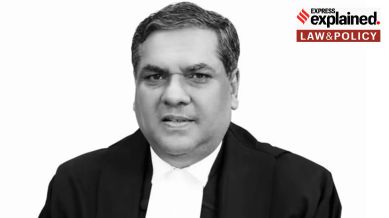Justice Sanjiv Khanna to be next CJI: How are Chief Justices of India appointed?
Justice Khanna, the seniormost judge in the apex court, will succeed CJI Chandrachud a day after the latter’s retirement on November 10. Here is how the process works.

The Centre on October 24 appointed Justice Sanjiv Khanna as the next Chief Justice of India (CJI), formally approving the recommendation made by CJI D Y Chandrachud a week ago.
Justice Khanna, the seniormost judge in the apex court, will succeed CJI Chandrachud a day after the latter’s retirement on November 10. He will hold the post for a little over six months until his retirement on May 13, 2025. CJI Chandrachud’s two-year term is among the longest in recent years.
What is the process for appointing the CJI?
BASIS OF APPOINTMENT: The MoP says that the “appointment to the office of the Chief Justice of India should be of the seniormost Judge of the Supreme Court considered fit to hold the office”. Even before the MoP was agreed upon in 1999, the seniormost judge of the Supreme Court after the CJI was by convention elevated to the top post.
HOW THE PROCESS BEGINS: According to the MOP, the appointment process begins when “The Union Minister of Law, Justice and Company Affairs would, at the appropriate time, seek the recommendation of the outgoing Chief Justice of India for the appointment of the next Chief Justice of India”. By convention, the “appropriate time” for the process to begin is a month before the date of retirement of the incumbent CJI. CJI Chandrachud sent his letter of recommendation to the Centre on October 17.
CENTRAL GOVERNMENT APPROVAL: As per the process laid down in the MoP, “after receipt of the recommendation of the Chief Justice of India, the Union Minister of Law, Justice…will put up the recommendation to the Prime Minister who will advise the President in the matter of appointment”. Though the final word on appointing the next CJI technically lies with the Centre, by convention the Centre tends to appoint whoever the presiding CJI recommends as her successor.
|
Table: The next in line to be Chief Justice of India Story continues below this ad Since all SC judges have to retire at the age of 65, the length of a CJI’s tenure depends on how old they are at the time of their predecessor’s retirement. Here is a list of judges slated to be the CJI in the near future. |
|||
|
Judge |
Date of assuming office (DD/MM/YY) |
Retirement Date (DD/MM/YY) |
Length of Tenure |
|
Justice Sanjiv Khanna |
11.11.2024 |
13.05.2025 |
184 days |
|
Justice B R Gavai |
14.05.2025 |
23.11.2025 |
194 days |
|
Justice Surya Kant |
24.11.2025 |
09.02.2027 |
443 days |
|
Justice Vikram Nath |
10.02.2027 |
23.09.2027 |
226 days |
|
Justice B V Nagarathna |
24.09.2027 |
29.10.2027 |
36 days |
|
Justice P S Narasimha |
30.10.2027 |
02.05.2028 |
186 days |
|
Justice J B Pardiwala |
03.05.2028 |
11.08.2030 |
831 days |
|
Justice K V Viswanathan |
12.08.2030 |
25.05.2031 |
287 days |
|
Note: The dates in the table above work on the assumption that each of these judges will be the seniormost judge in the SC when they assume the office of CJI. The above information may change based on any changes in convention, early resignation, or loss of life. |
|||
Has there ever been a departure from the convention of appointing the seniormost SC judge as the CJI?
Yes. This convention was famously discarded by former Prime Minister Indira Gandhi, whose government recommended the appointment of Justice A N Ray as CJI in 1973, superseding three more senior judges, Justices J M Shelat, K S Hegde, and A N Grover.
Justice Ray was considered to be more favourably disposed towards the Indira government than his more senior colleagues. His appointment was announced the day after the Supreme Court pronounced a landmark order in the Kesavananda Bharati case, which laid down the “basic structure” doctrine. Justice Ray was part of the minority in the 7-6 verdict of the 13-judge Bench.
Indira’s government, in January 1977, once again ignored the convention by superseding Justice H R Khanna to appoint Justice M H Beg as the CJI. Justice Khanna had been the lone dissenter in the ADM Jabalpur vs Shiv Kant Shukla order, in which the majority comprising Justices A N Ray, P N Bhagwati, Y V Chandrachud, and M H Beg agreed with the government that fundamental rights including the right to life and liberty stood abrogated during a period of national Emergency.
How did the MoP come into existence?
Following the apex court’s decisions in the First Judges Case (1981), Second Judges Case (1993), and the Third Judges Case (1998), a peer selection process for the appointment of High Court and SC judges was put in place by establishing what we now know as the Supreme Court Collegium. This Collegium comprises the seniormost judges of the SC, and the Centre is technically bound to accept its recommendations.
The MoP — first drawn up in 1999 — provides the procedure for appointment and obligations of the Centre, the SC, and the High Courts when it comes to the appointment process. This document is crucial as the Collegium system of appointing judges is a judicial innovation that is not mandated through legislation, or text of the Constitution.
In 2015, the SC struck down the constitutional amendment that brought in the National Judicial Appointments Commission (NJAC). This would have allowed the Centre to have greater influences in the process of recommending judges. Following this decision, the MoP was renegotiated in 2016, although the government maintained until last year that it was still being finalised.